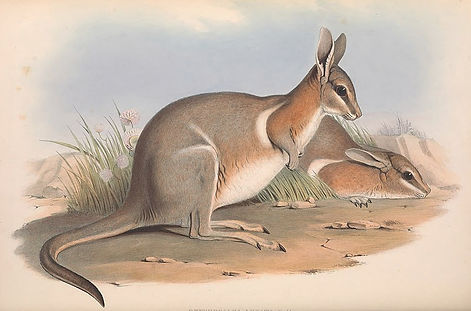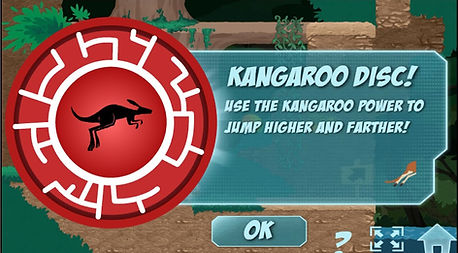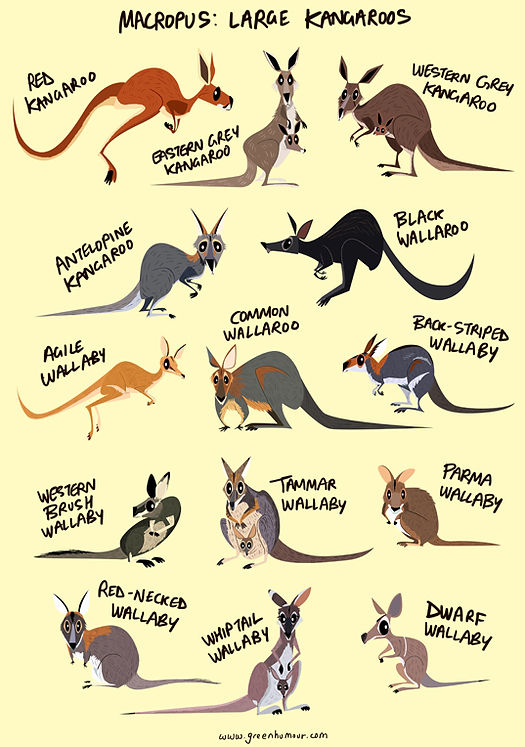Creature
Fast Facts
Introducing you to extinct species.

THE WORONG/
CRESCENT NAILTAIL WALLABY
1) The worong, Onychogalea lunata, was part of the macropod family which includes kangaroos and wallabies. 2) It was one of three species of nailtail wallabies, which got their name due to a spur at the tip of their tail. 3) It went by many names including the worong, crescent nailtail wallaby, kangaroo rabbit, & "tjawalpa" or "warlpartu" by the native Aboriginees. 4) It lived in Southwestern Australia. 5) They were very timid and would hide in logs, like a hare/rabbit, when startled. 6) It was the only kangaroo or wallaby species to be seen twitching its tail in an upward motion. 7) The worong weighed 7.5 pounds and was 33 inches in total length. 8) It was commonly hunted for food by Aborigines and farmers and reported to look like chicken, but tasted like rabbit. 9) The last living specimen was captured in a dingo trap on the Nullarbor Plain in 1927 and sent to the Taronga Zoo. 9) The last confirmed report of a crescent nailtail wallaby was in 1956. 10) The bridled nailtail wallaby (flash jack) & the northern nailtail wallaby are living relatives of the crescent nailtail wallaby.
Extinction
Cometh
Facing the light at the end of the tunnel
EXTINCTION DATE
1956
The worong or crescent nailtail wallaby was a very common marsupial of south western Australia. It lived in various types of vegetation and acted similar to a rabbit. When disturbed they would retreat into logs where they were easily captured. In one survey in 1907 collected 18 specimens. Around 1908, the population of crescent nailtail wallabies plummeted. No one knows exactly what caused the steep decline in their population. There were many factors such as clearing land for sheep grazing and farms. The crescent nailtail wallabies also had to compete against invasive species like the "gray blanket" aka the escalated rabbit population. The introduction of the red fox in the 1870's for recreational hunting and feral cats also took their toll on this small marsupial. The last living worong was caught in a dingo trap on the Nullarbor Plain in 1927 or 1928. Mr. Mills sent it to Taronga Zoo. It is thought that the last crescent nailtail wallaby died in the more isolated arid areas of its range around 1956. As of 2019, 100 species, including the crescent nailtail wallaby, have gone extinct since the arrival of Europeans to Australia. Could the crescent nailtail wallaby live in Australia today? Although Jurassic Park is fiction, scientists are working on several de-extinction projects. In fact, in 2003 scientists did bring back the extinct Pyrenean ibex, a type of wild goat, for 7 minutes before it died, showing de-extinction is possible. The worong could be a good candidate. Scientists would have many specimens that were collected in the early 1900's during population surveys. Australia has made many strides in restoring natural habitats, eliminating invasive species, and helping struggling species recover. If the worong was brought to life, could it ever be reintroduced to its native homeland in Australia?
COMING SOON
The crescent nailtail wallaby's Lazarus tale has yet to be written, but what adventures will await it when it returns to the southwestern part of Australia? Stay tuned to find out.
More to Explore
All answers lead to more questions
Crescent nail-tail specimen
Image from Twitter
VIDEOS & ADDITIONAL INFO
10 Recently Extinct Marsupials
Surveying Flashjacks on Avocet
Australian Wildlife Conservancy Video
Kangaroos - Wild Kratts Video Clip

Crescent nail-tail wallaby painting
Image from Wikipedia




A Gap in Nature Book
Image from Amazon
Crescent nail-tail wallaby Image from A Gap in Nature
Crescent Nail-tail wallaby Image from Hansa Creation

Bridled nailtail wallaby Image from Featured Creature

Surveying "Flashjacks", a nickname for the bridled nailtail wallaby
Image from Bush Heritage Australia

All nail-tail wallabies have a spike at the end of their tails Image from Bush Heritage Australia/ Facebook



Kangaroo power
Image from Wild Kratts Games
Wallaby stamp
Image from Hip Stamp
Wild Kratts - Wow Fact
Image from Facebook

Macropod species
Image from Green Humour

Nailtailed wallaby $25 gold coin
Image from NGC



